Ernest instructions
Ernest is an elastomer tray that has 3×3, 4×4 or 5×5 cavities depending on its versions and allows you to search for glaze quickly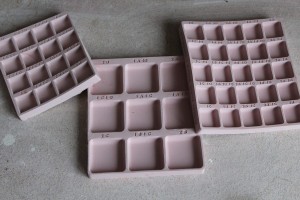
The 5×5 has a general use, the 3×3 having larger boxes is intended for ceramists looking for effect glazes. The 4×4 offers the advantage of using smaller tiles.
One of Ernest’s strengths is to remove the use of the brush for transferring the container to the sample tile. Tiles of size 14 x 15,5 cm will be used for 5×5 and 3×3 and 11×12 cm for 4×4. These tiles should be smooth and as flat as possible.
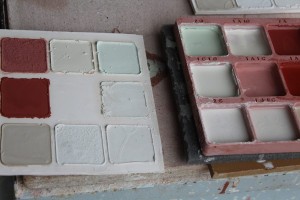
To use Ernest it will be necessary to manufacture laths covered with foam (5 to 10 mm thick) of dimensions 14 x 15,5. Foam will be glued to the board
1 mL, 3 mL and 10 mL syringes complete the required material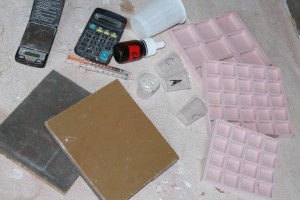
Dilution
For a correct use of Ernest it is necessary to pay great attention to the dilution of Dry Materials ( MS ) in water. For the first tests, you can stick to a dilution of 1.6 g of water per 1 g of MS. Which would be way too much for normal use.
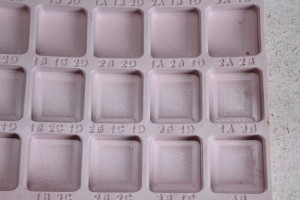
Ernest’s boxes are ‘’ numbered ‘’
This means that the box for example 1B,2C,1D corresponds to 1 dose of B + 2 doses of C + 1 dose of D.
We will see what the dose is later.
Several possible uses of Ernest
Progression in two directions
When looking for an enamel, we start from a base and we limit ourselves to varying two components (we could vary 3 or 4 components at a time, but the result would be difficult to interpret) Stull diagrams are based on Alumina Silica variations in a given database
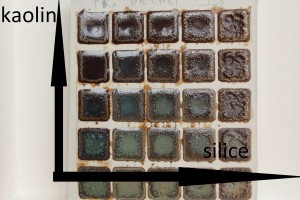
Example
Either a base B of 20 g
12.6 g feldspar, 4.4 g dolomite, 2 g silica and 1 g kaolin
To this base we add 20×1,6 of water or 32 g of water. This base we divide it in 4 buckets A,B,C and D therefore (20+32) /4 = 13 g per bucket. In A we add 0,50 of kaolin, in B we add nothing, in C we add 1 of silica and in D we add 0,5 of kaolin and 1 of silica. This gives us a recipe for A B C and D
|
B |
B per cup |
A |
A per cup |
C |
C per cup |
D |
D per cup |
|
|
Felds |
12,6 |
3,15 |
12,6 |
3,15 |
12,6 |
3,15 |
12,6 |
3,15 |
|
Dolomite |
3,4 |
0,85 |
3,4 |
0,85 |
3,4 |
0,85 |
3,4 |
0,85 |
|
Silica |
2 |
0,5 |
2 |
0,5 |
6 |
0,5+ 1 |
6 |
0,5+ 1 |
|
Kaolin |
1 |
0,25 |
3 |
0,25 +0,50 |
1 |
0,25 |
3 |
0,25 +0,50 |
An other words, we add for A 10% kaolin, for C 20% silica and D 10% kaolin and 20% silica
Once our 4 buckets are prepared, we can add a drop of yellow food colouring for the A, red for the C and blue for the D. This allows us not to make any errors in the dosage that will follow.
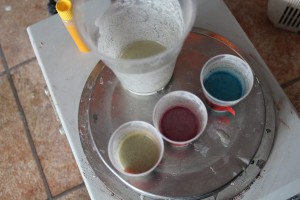
Ernest is placed on his foam and the distribution is done with a syringe following the indications mentioned for each box of Ernest. For the Ernest 5×5 we will take as a dose 0,2 ml that is in each case there are 4 doses or 0,8 ml For the 4X4 we will take as a dose 0,3 ml and in each case there is 0,9 ml. For the 3×3 we will take 1.5 ml as a dose and there are two doses per box so 3 ml.
The fastest method is to start with the A for example for the 5×5 , we put 4 doses of A or 0,8 ml in box 4A , then 3 doses (0,6 ml) in the 3A1B etc etc we continue with the B by putting what is indicated on Ernest etc etc. When we have filled all our locker, Add +or- 0.5 ml ( precision does not matter) per water box to facilitate turning. Cover with a plate and shake to mix the contents. We replace this plate with our tile where we will have previously noted on the back our recipe and the additions. We shake, we return, we wait a little. We take Ernest out, we just have to put our tile in the oven. We then know that we have about the same amount of MS per cell and therefore the same thickness of enamel.
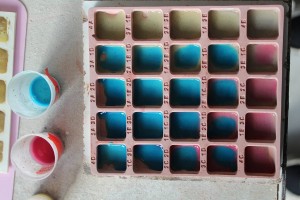
To calculate the recipe of a given box for example 2A 1C 1D it is enough to take the recipe of A multiplied by the coefficient 2, add the recipe of C and that of D. In the example given above with an addition of 10% in vertical for kaolin and 20% in horizontal for silica , there is no need to take out the calculator to see that kaolin will be 0% added on the bottom line then 2.5% on the top line…idem for columns for kaolin…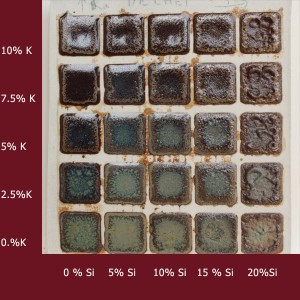
Vidéo correspondante
Nuancier
Another way to use Ernest is to add to the dropper of materials that are used in small quantities in enamel such as dye oxides, titanium, tin…
The principle is to deposit the same amount of enamel in each box and to make additions to the droplets of these materials.
We fill dropper vials with 0.8 g of oxide for 10 ml of water ( we can add a little suspensive to avoid this lead exaggerated in the bottle) In this case there will be 0.004 g of oxide per drop in our bottle. If we use the dilution of 1,6 g of water for 1 g of MS and we put 0,8 ml per box, we will have 0,4 g of MS per box so the addition of a drop of the diluted oxide of our bottle will correspond to an addition of 1% of oxide. For oxides such as cobalt it will be necessary to dilute (5 times more for example) so that a drop will correspond to 0.2% for example. In the video I put 1 ml of enamel per box but diluted to 21 g of water for 10 g of MS which is the same for the amount of MS.
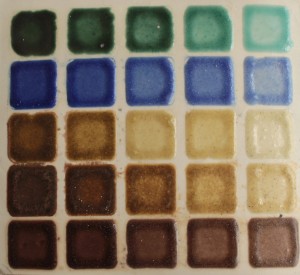
vidéo
Superpositions.
.Another use that saves time compared to traditional methods is to use Ernest a little differently. For example, if we want to test the superposition of two different enamels and we have 9 enamels to test, we put each of our enamels in a Ernest 3×3 box. Then after placing our tile on Ernest we briefly return, we re-return, we then have on Ernest the 9 squares with different enamels. We “print” our 9 tiles. On each of our tiles, one of the 9 enamels is then sprayed or soaked. We have 81 tests, 72 of which are overlays. The other 9 where a first layer of enamel is covered with the same enamel serves as a reference on our tile.
Thickness test
It is always interesting to test the same glaze at different thickness. In this method of use I recommend to use a dilution of 16 g of water for 10 g of MS this is valid for a first approach of a search but it turns out that some families of enamels require a more or less important thickness. In the Ernest 5×5, 0.8ml per cell gives an enamel at 10 gr per dm² if a dilution of 16 g per 10 ms is used. We can test the influence of thickness on the rendering of an enamel using a single line of this Ernest. To do this we will deposit 0,4ml, 0,6ml, 0,8ml, 1ml, 1,2ml of enamel in the 5 boxes of the same line to which we add 0,5ml of water to facilitate the retornement and we transfer on a tile. We will then have the same enamel passed respectively to 5 g, 7,5 g, 10 g, 12,5g, 15 g per dm².
Zoom
When an interesting area has been found with a first test It is advisable to repeat a test by refining. For this we change base and we decrease the additions
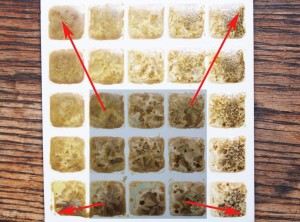
Preparation of the tiles
A quick way is to do them by pouring them onto a plasterboard. They can also be done with a cruster or roller. Their cutting will be leather consistency and in any case it is good to dry them in a pile to avoid their warping.video
To go further on the volume dosage and visualize the tables that link thickness and dilution and various calculations concerning Ernest en français Document to download
If you want to acquire an Ernest my shop on Etsy
